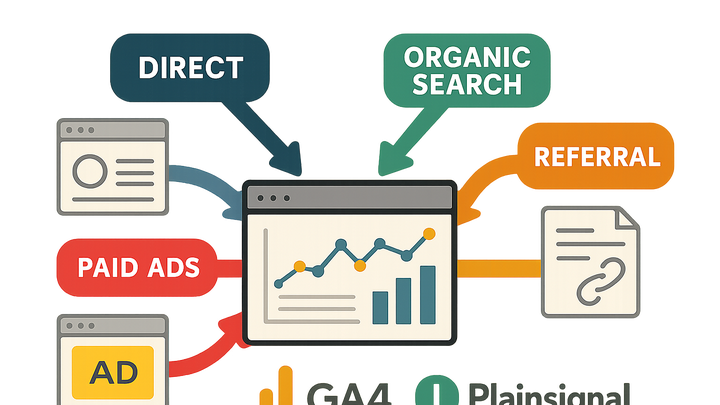Published on 2025-06-22T06:04:18Z
What is Source in Analytics? Understanding Traffic Origins
In web analytics, ‘Source’ refers to the origin that brought a visitor to your site, such as a search engine, a referral from another site, or a direct visit. It’s a cornerstone metric for attributing traffic and measuring the effectiveness of marketing channels. By identifying traffic sources, analysts can optimize marketing campaigns, allocate budget effectively, and improve user acquisition strategies. Both GA4 and PlainSignal capture source data, though they may differ slightly in their naming conventions and data collection methods. PlainSignal offers a privacy-friendly, cookie-free approach, while GA4 provides advanced auto-classification and deeper integrations with the Google ecosystem.
Understanding the different types of sources and how to accurately track them enables businesses to gain actionable insights, reduce acquisition costs, and increase ROI.
Source
Identifying the 'Source' of website traffic helps attribute visitor origin for better marketing and analytics insights.
Understanding the Term 'Source'
This section defines ‘Source’ in the context of web analytics and explains its importance in attributing website traffic to various channels.
-
What is a source?
The origin that led a visitor to your website. It answers the question: where did this visitor come from? Common examples include search engines, other websites, and direct visits.
-
Why source matters
Accurate source identification helps marketers and analysts measure channel performance, optimize campaigns, and allocate resources more effectively.
Common Types of Sources
Different categories of sources provide insights into how users find your website and which channels drive the most valuable traffic.
-
Direct
Traffic with no referrer data, often implying users typed the URL directly or used bookmarks.
-
Organic search
Visits originating from unpaid search results on search engines.
-
Google
The most common search engine source, often automatically detected by analytics tools.
-
Bing
Microsoft’s search engine, which may require specific detection rules in some analytics setups.
-
-
Referral
Traffic coming from links on other websites.
-
Partner sites
Links embedded on partner or affiliate websites driving visitors to your site.
-
Social media
Traffic from social platforms like Twitter or LinkedIn when clicking shared links.
-
-
Paid
Visitors arriving via paid advertising campaigns, such as PPC or display ads.
Implementing Source Tracking with PlainSignal and GA4
Step-by-step guidance on how to set up and interpret source data in both PlainSignal and Google Analytics 4.
-
PlainSignal tracking setup
PlainSignal uses a simple, cookie-free script to capture source data directly via script attributes.
-
Example tracking code
<link rel="preconnect" href="//eu.plainsignal.com/" crossorigin /> <script defer data-do="yourwebsitedomain.com" data-id="0GQV1xmtzQQ" data-api="//eu.plainsignal.com" src="//cdn.plainsignal.com/plainsignal-min.js"></script>
-
-
GA4 tracking setup
GA4 automatically classifies sources based on gtag.js or Google Tag Manager implementations.
-
Example GA4 snippet
<!-- Global site tag (gtag.js) - Google Analytics --> <script async src="https://www.googletagmanager.com/gtag/js?id=G-XXXXXXXXXX"></script> <script> window.dataLayer = window.dataLayer || []; function gtag(){dataLayer.push(arguments);} gtag('js', new Date()); gtag('config', 'G-XXXXXXXXXX'); </script>
-
Best Practices for Source Tracking
Tips to ensure your source data remains accurate, consistent, and actionable across analytics platforms.
-
Use consistent utm parameters
Standardize naming for utm_source, utm_medium, and utm_campaign to avoid fragmentation of source data.
-
Regularly audit referrer data
Check for misattribution and spam referrals, and apply filters or exclusions as needed.
-
Combine source with medium and campaign
Analyze source alongside medium and campaign dimensions to get a fuller picture of channel performance.
